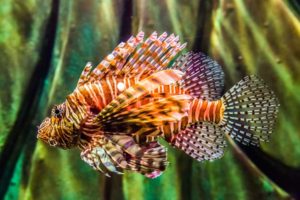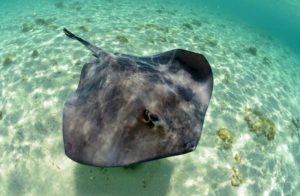
With the return of warm weather, Vero beaches are about to get crowded – and, sometimes, downright dangerous, according to Dr. Peter Marzano, a hospitalist with the Indian River Medical Center.
 But he says it’s not sharks people should worry about. He knows firsthand there are scarier – albeit smaller – creatures in Florida’s waters.
But he says it’s not sharks people should worry about. He knows firsthand there are scarier – albeit smaller – creatures in Florida’s waters.
Marzano, who says he “grew up in Fort Lauderdale and Melbourne,” has been “on the water” all his life and is still a competitive surfer, is about as blasé as possible when it comes to sharks.
“Sharks are not going to hurt you,” he calmly states. “They’re not out to get you.” On those rare occasions when a shark does bite a human, Marzano claims, it’s almost always a case of “mistaken identity.”
Venomous fish, on the other hand, are something the doctor says he always keeps on eye out for, whether he’s catching a wave here, or in Hawaii, or off the shores of South Africa.
Florida’s waters are rife with venomous sea creatures, according to Marzano.
From stingrays to scorpion fish to lionfish to stonefish to stinging jellyfish, being a victim of what Marzano calls “marine envenomation” can be a painful and sometimes life-threatening experience.
Let’s start with stingrays. As a Washington Post “Health and Science” advisory reports, signs posted along some Florida beaches and estuaries advising waders to do the “stingray shuffle” instead of normal foot-up, foot-down walking in shallow water is “not a ploy to make tourists look silly.”
“Shuffling carefully, one foot at a time,” says the Post, “creates gentle vibrations that alert stingrays to your presence.”
That’s important because “startling or stepping on a stingray,” according to the Post, “can trigger its self-defense mechanism. In many species, that’s [a strike from] a nasty, serrated, venom-injecting tail.”
Some 1,500 people are speared by those stingray tails in Florida each year.
The National Center for Emergency Care Information bluntly describes the result as “immediate, local, intense pain, edema of soft tissue and a variable amount of bleeding. The pain peaks after 30 to 60 minutes, may radiate centrally and can last up to 48 hours.”
Marzano, who – when on dry land – has also served as the spring training team doctor for major league baseball’s Washington Nationals, is quick to add, “We have plenty of stingrays here. The one everyone steps on here is the Atlantic stingray.
 “They spend a lot of their juvenile time in the Indian River and again there’s venom in the barb,” Marzano continues. “You get two issues with that. You’ve got the puncture wound, usually in the lower extremities, and then you have the toxin – it’s a neuro toxin,” meaning it attacks the body’s nervous system.
“They spend a lot of their juvenile time in the Indian River and again there’s venom in the barb,” Marzano continues. “You get two issues with that. You’ve got the puncture wound, usually in the lower extremities, and then you have the toxin – it’s a neuro toxin,” meaning it attacks the body’s nervous system.
Next on Marzano’s list of marine envenomation culprits are the scorpion fish, the lionfish and the stonefish. Two of the three are “illegal aliens,” or invasive species. The least venomous is the scorpion fish, which is indigenous to Florida.
The National Institutes of Health claims “stonefish are one of the most venomous fish in the world with potential fatal local and systemic toxicity effects to human.” Even if treated promptly, recovery from a jab of a stonefish barb or quill “usually takes about 24 to 48 hours.”
Originally native to the waters off Australia, the stonefish can now be found throughout Florida waters and the Caribbean.
Lionfish also are native to the South Pacific and Indian oceans but have been introduced to this area. Their range appears to be spreading. They have been reported from Florida to North Carolina and as far north Long Island, New York, in waters as shallow as 1 foot and as deep as 300 feet.
Finally, Florida has its fair share of jellyfish – though the most feared and best known isn’t a jellyfish at all. The Portuguese man-of-war, according to the National Oceanic and Atmospheric Administration, “is actually a species of siphonophore.”
Back in mid-February, hundreds of these creatures washed up onto south Florida beaches. As the Sun-Sentinal reported, “in Delray Beach, most of the 358 minor medical incidents on the beach so far this month have been Portuguese man-of-war stings.”
According to National Geographic, “a man-of-war sting is excruciatingly painful, but rarely deadly. But beware – even dead man-of-wars washed up on shore can deliver a sting.”
Scared? That’s not what Marzano wants. What he does want is for people to know what’s out there and how to best cope with any marine envenomation that might come their way.
Websites for organizations such as the American Academy of Underwater Sciences, NIH and NOAH are an excellent place to start.



